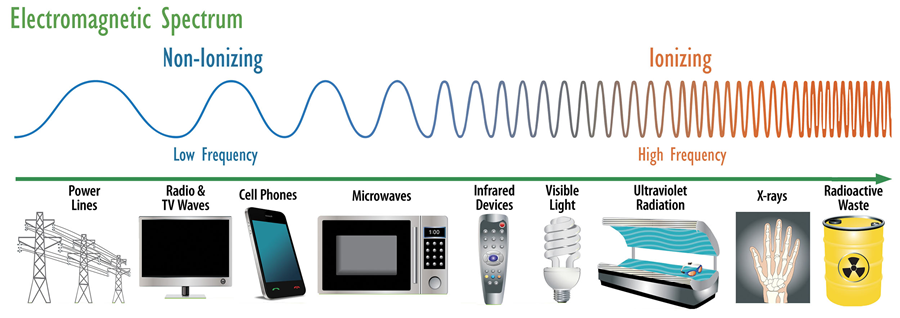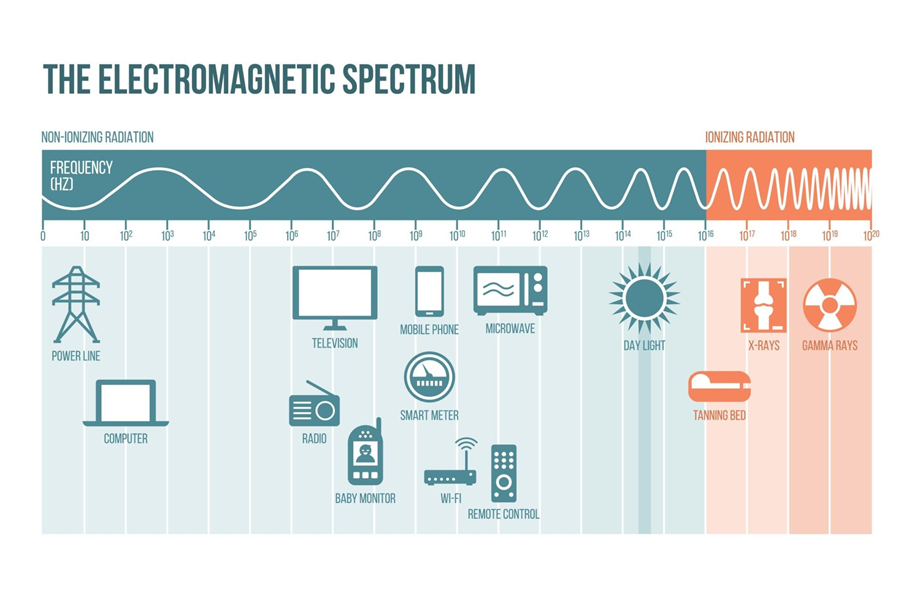EMF 101: What Is EMF & Why Is It Important?
What Does EMF, EME, and EMR Stand For?
What are Electromagnetic Fields?
Electromagnetic Fields (EMF) are also known as electromagnetic energy (EME) and electromagnetic radiation (EMR). Present in all current flows and voltages, we are surrounded by EMF every day. These invisible fields of energy can occur naturally from the earth but can also be generated through radio and television transmission related industries.
From microwaves, X-ray equipment, cameras, television, to GPSs, all forms of EME are referred to as an electromagnetic spectrum. Varying in different wavelengths and frequencies, EME properties may be different when interacting with matter.
Are EMFs & Radiation the Same?
Sometimes, EMF is simply referred to as radiation; however, there are two types of radiation. To be more precise, “electromagnetic fields” (EMF) refers to the physical fields produced by electromagnetic non-ionizing radiation.

Image from the National Institute of Environmental Health Sciences (NIEHS)
Non-Ionizing Radiation
Non-ionizing radiation is when electromagnetic fields do not have enough energy to remove tightly bound electrons from atoms or molecules. In other words, non-ionizing is less harmful to living organisms due to low energy levels. Some common sources of non-ionizing radiation are microwaves, visible light sources, radios, cell phones, and electric vehicles.
Ionizing Radiation
Ionizing radiation is the opposite of non-ionizing radiation. With its high levels of energy, ionizing radiation can remove tightly bound electrons from atoms or molecules, resulting in the formation of ions. In other words, this type of radiation can have damaging effects on DNA and cellular matter, including an increased risk of cancer. Some common sources of ionizing radiation include medical X-ray machines, nuclear power plants, and other natural radioactive materials.

Image from Energy Education.CA, University of Calgary
Is EMF Harmful to My Health?
Although we are exposed to EMF waves daily, long intense exposures to electromagnetic field currents may deteriorate our physical health. At low frequencies, the currents may cause irritation to our nerves and muscles. In higher frequencies, those exposed may feel their body heating up. Effects vary depending on proximity, and certain frequencies affect certain areas of the body more than others, depending on the tissue being exposed. Areas of minimal circulation, such as the eyes, are most vulnerable. Those who have injuries prior to exposure may experience very minimal risk of cancer, hormonal imbalances, or weakening of the immune system due to sensitivity. To ensure safety, it is best to proceed with caution towards any application that emits EMF radiation.
The Key Elements to Electromagnetic Fields
Traveling in waves at the speed of light (c), EMF wavelength measurements vary on the frequency (f), which is measured in hertz (Hz). A near field region means the distance from the field source is less than three wavelengths away, usually during low frequencies of 30 kHz and below. Distances that are seen to be greater than three wavelengths (30 kHz) are considered the far field region.
Understanding how near and far fields are being measured is crucial. When configuring the relationship between the magnetic field strength (H, A/m) and the electric field strength (E, V/m) in the near field, they must be measured separately since there is no constant. However, the far field only needs one field quantity calculated since there is already a constant relationship. The magnetic field is so strong that it permeates through all known building materials. Unlike the magnetic field, the electric field can be measured by simply using a thin earth metal sheet.
The unit utilized for the electric field strength is volts per meter (V/m). The units for the magnetic field strength are amperes per meter (A/m) or magnetic flux density (B) in tesla (T) or gauss (G).
The Limit Values & Conversion Importance
Human safety specified by international agreement states that the basic limit values for current density (J) in milliamperes per square meter (mA/m2) is for low frequencies and for the specific absorption rate (SAR) in watts per kilogram (W/kg) for high frequencies. Due to the complex nature of fundamental values, measurements of the electric and magnetic field strength are conducted using derived quantities from the fundamental units.
Today, the field strengths recommended by the ICNIRP (International Commission for Non-Ionizing Radiation Protection) are recognized as the foundation for the national standards and laws worldwide.
EMF conversions are essential to express measurements, ensure consistency and compliance with safety standards, as well as transfer knowledge between cross-disciplinary research.
How ATEC Can Assist You
Here at ATEC, we provide various EMF safety measurement rentals, as well as providing calibrations at our in-house lab. We carry innovations from many manufacturers including Narda STS, Wavecontrol, Schwarzbeck, and many others.
